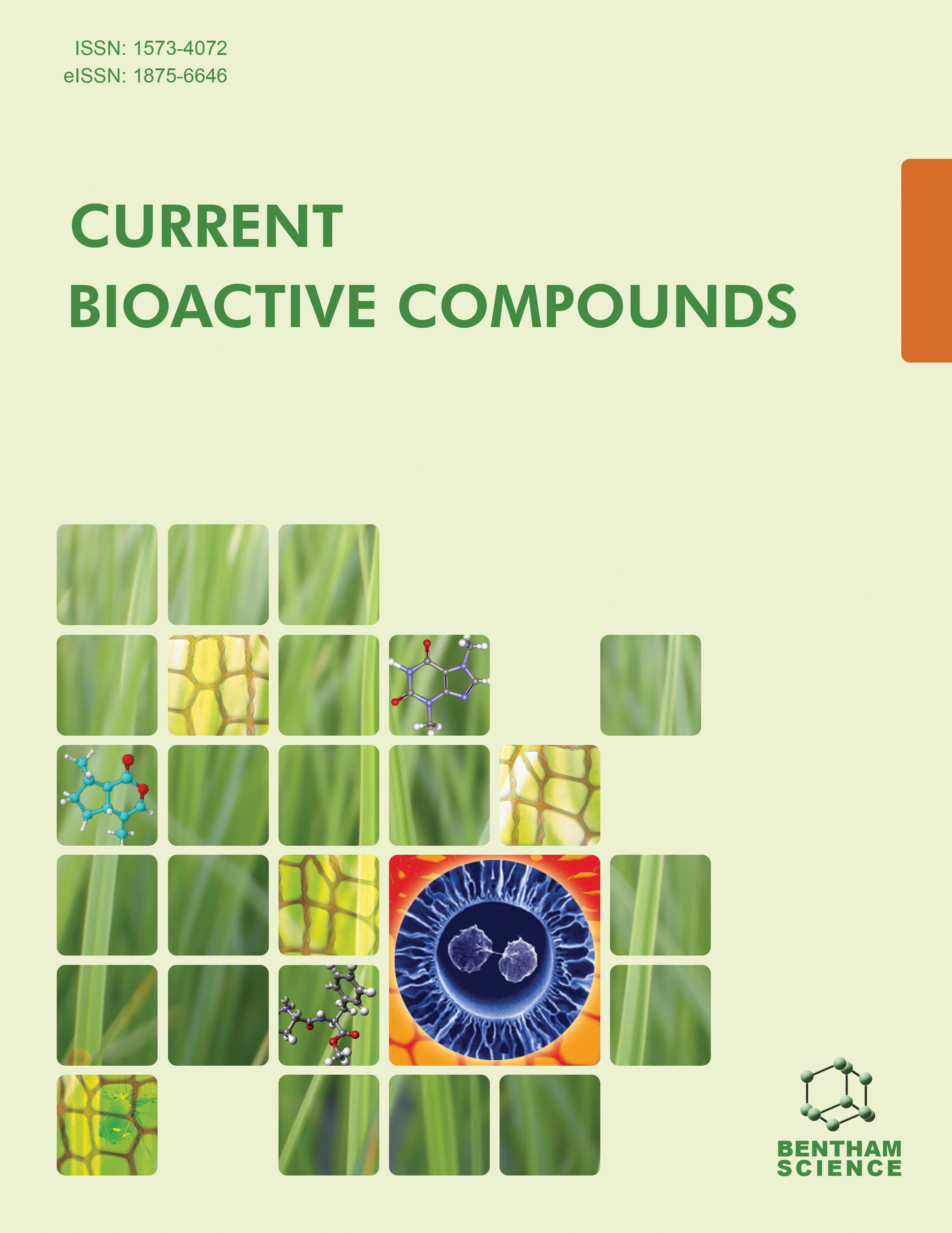- Home
- A-Z Publications
- Current Bioactive Compounds
- Previous Issues
- Volume 10, Issue 1, 2014
Current Bioactive Compounds - Volume 10, Issue 1, 2014
Volume 10, Issue 1, 2014
-
-
Nutraceuticals: Beyond the Diet Before the Drugs
More LessAuthors: Antonello Santini and Ettore NovellinoDiet and lifestyle are considered essential to promote and maintain the well-being as well as to prevent the onset of diseases linked to wrong lifestyle and dietary habits that can both determine pathological conditions. Many of these require pharmacological therapy; nevertheless, some can be prevented and taken care of with the use of nutraceuticals in the daily diet. Nutraceuticals are pharmacologically active substanc Read More
-
-
-
DNA Cleaving “Tandem-Array” Metallopeptides Activated With KHSO5: Towards the Development of Multi-Metallated Bioactive Conjugates and Compounds
More LessAuthors: Mark A. Lewis, Katie M. Williams, Ya-Yin Fang, Franklin A. Schultz and Eric C. LongAmino terminal peptides of the general form Gly-Gly-His have been used to introduce single sites of metal binding and redox activity into a wide range of biomolecules to create bioactive compounds and conjugates capable of substrate oxidation. We report here that Gly-Gly-His-like peptides linked in a tandem fashion can also be generated leading to multi-metal binding arrays. While metal binding by the native Gly-Gly-His m Read More
-
-
-
Extracts of Bacopa monnieri (L) Pennell Down-Regulate the Expression of Leukotriene C4 Synthase mRNA in HL-60 Cells and Suppress OVAInduced Inflammation in BALB/c Mice
More LessAims: To investigate the in vitro and in vivo anti-inflammatory effects of Bacopa monnieri extracts in HL-60 cells and in OVA-induced airway inflammation in BALB/C mice. Materials and Methods: Bacopa monnieri (Brahmi) leaves and stems were collected in Vidisha (M.P.), India, identified and air-dried. The dried plant materials were pulverized to a powder, extracted in methanol to exhaustion, dried and fractionated. The e Read More
-
-
-
Tyrosinase Inhibitors from the Fruits of Madhuca latifolia
More LessAuthors: Shazia Khan, Mahmud Tareq Hassan Khan and M. Nadeem KardarTyrosinase is a copper-containing enzyme that catalyzes melanin synthesis in skin melanocytes by oxidation. Eighteen compounds of different classes, i.e., pentacyclic triterpenes, flavonoids, steroids, aromatics, mono and triglycerides and straight chain hydrocarbons were isolated from the fruit pulp and seeds of Madhuca latifolia and were identified as betulinic acid 3-β-caprylate (1), stigmasterol (2), ursolic acid (3), p-hydro Read More
-
-
-
Effect of Some Triterpene Glycosides Applied in vitro on Chromatin State in Human Cells
More LessThe effect of triterpene glycosides - monoammonium salt of glycyrrhizinic acid (monoammonium glycyrrhizinate) and of alpha-hederin and hederacoside C from ivy (Hedera L.) on chromatin condensation in human buccal epithelium cells was investigated. Heterochromatin granules in cell nuclei were stained with 2% orcein. The state of chromatin was assessed by heterochromatin granules quantity - HGQ at magnificati Read More
-
-
-
Cratylia mollis Lectin: A Versatile Tool for Biomedical Studies
More LessLectins are a heterogeneous group of proteins that specifically and reversibly bind to carbohydrates without altering their covalent structure. Advances in the plant lectin research have provided many insights into the role of carbohydrate- protein interactions, which have contributed to the development of various others (for example: oncology, immunology, microbiology, molecular biology and diagnostic). Isolectins isolated Read More
-
-
-
A Study on Nutrient and Medicinal Compositions of Selected Indian Garcinia Species
More LessAuthors: Utpala Parthsarathy and O.P. NandakishoreThe Genus Garcinia is one of the tropical underutilized medicinal fruit crops. It contains around 200 species, out of which 35 species are available in India. In India it is present in two different ecosystems, the Western Ghats and the Himalayan foot hills. G. indica, G. gummi-gutta, G. xanthochymus, G. subelliptica and G. mangostana are the common species of Western Ghats while G. lanceaefolia, G.pedunculata, and Read More
-
-
-
Marine Derived Bioactive Compounds for Breast and Prostate Cancer Treatment: A Review
More LessAuthors: Senthilkumar Kalimuthu, Jayachandran Venkatesan and Se-Kwon KimBreast cancer and prostate cancer are the most common invasive types of cancers in women and men. Many of the recent advances in understanding the pathophysiology of breast and prostate cancers have paved the way for new treatment strategies. The alarming increase in the global cancer death toll has fueled the quest for new effective anti-tumor drugs through biological screening of both terrestrial and mari Read More
-
Volumes & issues
-
Volume 21 (2025)
-
Volume 20 (2024)
-
Volume 19 (2023)
-
Volume 18 (2022)
-
Volume 17 (2021)
-
Volume 16 (2020)
-
Volume 15 (2019)
-
Volume 14 (2018)
-
Volume 13 (2017)
-
Volume 12 (2016)
-
Volume 11 (2015)
-
Volume 10 (2014)
-
Volume 9 (2013)
-
Volume 8 (2012)
-
Volume 7 (2011)
-
Volume 6 (2010)
-
Volume 5 (2009)
-
Volume 4 (2008)
-
Volume 3 (2007)
-
Volume 2 (2006)
-
Volume 1 (2005)
Most Read This Month
Article
content/journals/cbc
Journal
10
5
false
en

Most Cited Most Cited RSS feed
-
-
Podophyllotoxin: Current Perspectives
Authors: Ying Qian Liu, Liu Yang and Xuan Tian
-
- More Less

